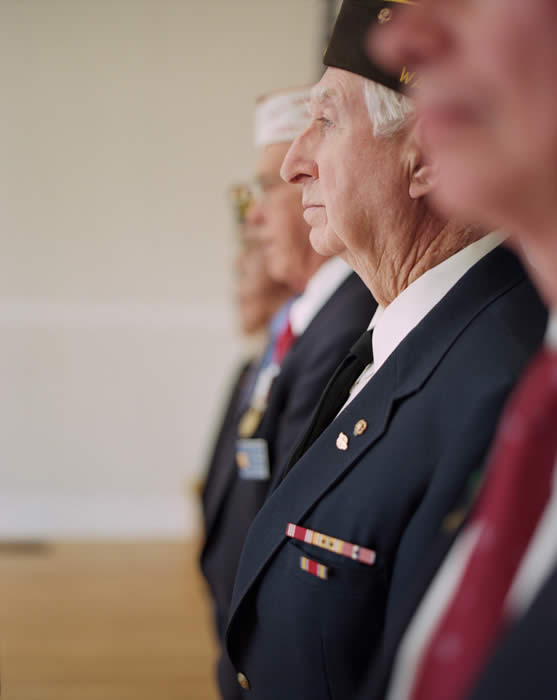Missouri Returning Heroes Act
The Missouri Returning Heroes Act, Section 173.900, RSMo, established August 28, 2008, as amended effective August 28, 2019, provides reduced tuition for certain combat veterans attending public institutions of higher education.
How does Missouri define combat veteran?

- Any military service in a combat zone. Combat Zones recognized by the Internal Revenue Service are on the IRS website. Please note this list may not be comprehensive. Your institution may need to contact the Missouri Veterans Commission to determine if your service was in a combat zone.
- For the purposes of the Missouri Returning Heroes Education Act, members of the Reserves or National Guard are considered veterans who served in the military as long as you served in armed combat in a full-time capacity under a call to active service authorized by the President of the United States or the Secretary of Defense for a period of more than thirty (30) consecutive days.
- Institutions will look at the following indicators to determine if you meet this requirement:
- Receipt of a combat service medal
- Bronze Star
- Combat Action Badge
- Combat Action Medal
- Combat Infantry Badge (Army)
- Combat Ribbon (Marine)
- Congressional Medal of Honor
- Global War on Terror (“GWOT”) Service Medal
- Global War on Terror (“GWOT”) Badge
- Purple Heart
- Any other Action Badge, Combat Medal, or Expeditionary Medal or Ribbon offered within a geographic area that enables the veteran to receive a combat pay tax exclusion exemption, hazardous duty pay, imminent danger pay, or hostile fire pay
- Receipt of a combat service medal
Information for Postsecondary Institutions
What are the educational benefits of the Missouri Returning Heroes Education Act?
Certificates and Associates/Bachelor’s Degrees
All public institutions of higher education must limit the amount of tuition such institutions charge to combat veterans to fifty dollars ($50) per credit hour, as long as the veteran achieves and maintains a cumulative grade point average (CGPA) of at least two and one-half on a four-point scale (2.5/4.0), or its equivalent.
Graduate Degrees
All public institutions of higher education must limit the amount of tuition the institutions charge to combat veterans to no more than thirty (30) percent of the cost of tuition and fees. The tuition limitation only applies to a combat veteran enrolled in a program leading to a graduate degree, including master and doctorate degrees. The definition of a “graduate degree" does not include professional degrees including but not limited to law, medicine, or veterinary degrees.
Who is eligible?
To be eligible for assistance the combat veteran must:
- Enroll at a Missouri public institution of higher education. A listing of public institutions can be found at https://dhewd.mo.gov/public-and-independent-colleges.php. In addition, enrollment must be in a program leading to a certificate, or an associate or baccalaureate degree, or a graduate degree;
- Have served in armed combat and provide military service documentation, such as the DD214,that reflects service in a combat theater, receipt of combat service medals, or receipt of imminent danger or hostile fire pay or tax benefits;
- Have been honorably discharged from military service;* and
- Be a registered voter in Missouri, or eligible to vote in Missouri, as determined by the Missouri Secretary of State, or a current Missouri resident.
* Fields 13, 24 and 28 on the DD214
How does the combat veteran maintain the benefits of the Missouri Returning Heroes Education Act?

The combat veteran is not initially required to have a 2.5 CGPA to receive the tuition reduction, even if the combat veteran has previously attended an institution of higher education. However, the combat veteran must achieve and maintain at least a 2.5 CGPA throughout the course of study to maintain eligibility for benefits in undergraduate programming.
What is the time limit on the benefits under the Missouri Returning Heroes Education Act?
The period during which a combat veteran is eligible for a tuition reduction on their undergraduate degree expires at the end of the ten (10) year period beginning on the date of the veteran's last discharge from service. The period during which a combat veteran is eligible for a tuition reduction for a “graduate degree” expires at the end of the twenty (20) year period beginning on the date of the veteran's last discharge from service. If the combat veteran is pursuing an undergraduate and graduate degree at the same time, the institution will apply the bachelor’s reduction to the undergraduate courses and the graduate reduction to the graduate courses.
What about other veteran benefits?
 If a combat veteran is eligible to receive any other type of financial assistance under any other federal or state student aid program, the tuition reduction may, at the combat veteran's discretion, be provided before all other federal and state aid for which the veteran is eligible has been applied. The public institution of higher education shall provide each combat veteran with written notice of this option and maintain a copy signed by the veteran in their official file.
If a combat veteran is eligible to receive any other type of financial assistance under any other federal or state student aid program, the tuition reduction may, at the combat veteran's discretion, be provided before all other federal and state aid for which the veteran is eligible has been applied. The public institution of higher education shall provide each combat veteran with written notice of this option and maintain a copy signed by the veteran in their official file.
Summary
- Must be an honorably discharged combat veteran
- Must vote in Missouri or be eligible to vote in Missouri, or be a Missouri Resident
- Must maintain a minimum of a 2.5 CGPA while enrolled in a certificate, associate, or baccalaureate, level program at a public institution of higher education
- Undergraduate cost is $50 per credit hour if completed within ten (10) years of the date of the combat veteran’s last discharge from service
- Graduate cost is no more than 30% of the cost of tuition and fees if completed within twenty (20) years of the date of the combat veteran’s last discharge from service
Examples
Certificate, or an associate or baccalaureate degree:
Example 1: Tuition Reduced Before Application of Federal and State Aid
In this example, the combat veteran is enrolled in 12 credit hours and the institution normally charges $100 per credit hour and total fees of $200. The combat veteran is eligible for a total of $500 in a combination of federal and state aid. The calculation on the left shows what the combat veteran would owe with the tuition rate under the Act. The calculation on the right shows what the combat veteran would owe with the normal institutional rate and is provided to demonstrate the savings under the Act.
With the Tuition Reduction |
|
Without the Tuition Reduction |
||||
|
12 |
Credit hours |
|
12 |
Credit hours |
|
x |
$50 |
Tuition rate under the Act |
x |
$100 |
Institutional tuition rate |
|
= |
$600 |
Tuition charged under the Act |
= |
$1,200 |
Normal tuition |
|
- |
$500 |
Federal & state aid applied to tuition |
- |
$500 |
Federal & state aid applied to tuition |
|
= |
$100 |
Tuition owed |
= |
$700 |
Tuition owed |
|
+ |
$200 |
Fees owed |
+ |
$200 |
Fees owed |
|
= |
$300 |
Total tuition & fees owed under the Act |
|
= |
$900 |
Total tuition & fees owed |
Example 2: Tuition Reduced After Application of Federal and State Aid
In this example, the combat veteran is enrolled in 12 credit hours and the institution normally charges $100 per credit hour. The combat veteran is eligible for a total of $500 in a combination of federal and state aid that covers five credit hours, leaving seven credit hours eligible for the tuition reduction. The calculation on the left shows what the combat veteran would owe with the tuition rate under the Act. The calculation on the right shows what the combat veteran would owe with the normal institutional rate and is provided to demonstrate the savings under the Act. It is important to note that in this scenario, if the total federal and state aid received covered all of the normal tuition (remaining normal tuition is $0), the tuition reduction would not apply.
With the Tuition Reduction |
|
Without the Tuition Reduction |
||||
|
12 |
Credit hours |
|
12 |
Credit hours |
|
x |
$100 |
Institutional tuition rate |
x |
$100 |
Institutional tuition rate |
|
= |
$1,200 |
Normal tuition |
= |
$1,200 |
Normal tuition |
|
- |
$500 |
Federal & state aid applied to tuition (covering 5 credit hours) |
- |
$500 |
Federal & state aid applied to tuition |
|
= |
$700 |
Remaining normal tuition (for 7 credit hours) |
= |
$700 |
Tuition owed |
|
- |
$350 |
Tuition reduction for remaining 7 hours (7 x $50) |
+ |
$200 |
Fees |
|
+ |
$200 |
Fees |
= |
$900 |
Tuition & fees owed |
|
= |
$550 |
Total tuition & fees owed under the Act |
|
|
|
|
Graduate (master or doctorate) degree
Example 1: Tuition Reduced Before Application of Federal and State Aid
In this example, the combat veteran is enrolled in 12 credit hours and the institution normally charges $100 per credit hour and total fees of $200. The combat veteran is eligible for a total of $300 in a combination of federal and state aid. The calculation on the left shows what the combat veteran would owe with the tuition rate under the Act. The calculation on the right shows what the combat veteran would owe with the normal institutional rate and is provided to demonstrate the savings under the Act.
With the Tuition Reduction |
|
Without the Tuition Reduction |
||||
|
12 |
Credit hours |
|
12 |
Credit hours |
|
x |
100 |
Institutional tuition rate |
x |
$100 |
Institutional tuition rate |
|
= |
$1,200 |
Normal tuition |
= |
$1,200 |
Normal tuition |
|
+ |
$200 |
Fees owed |
+ |
$200 |
Fees owed |
|
= |
$1,400 |
Tuition & fees owed before reduction |
= |
$1,400 |
Tuition & fees owed |
|
X |
.30 |
Reduction under the Act |
- |
$300 |
Federal & state aid applied to tuition |
|
= |
$420 |
Tuition charged under the Act |
|
= |
$1,100 |
Total tuition & fees owed |
- |
$300 |
Federal & state aid applied to tuition |
|
|
|
|
= |
$120 |
Total tuition & fees owed under the Act |
|
|
|
|
Example 2: Tuition Reduced After Application of Federal and State Aid
In this example, the combat veteran is enrolled in 12 credit hours and the institution normally charges $100 per credit hour and total fees of $200. The combat veteran is eligible for a total of $300 in a combination of federal and state aid that covers three credit hours, leaving nine credit hours eligible for the tuition reduction. The calculation on the left shows what the combat veteran would owe with the tuition rate under the Act. The calculation on the right shows what the combat veteran would owe with the normal institutional rate and is provided to demonstrate the savings under the Act. It is important to note that in this scenario, if the total federal and state aid received covered all of the normal tuition (remaining normal tuition is $0), the tuition reduction would not apply.
With the Tuition Reduction |
|
Without the Tuition Reduction |
||||
|
12 |
Credit hours |
|
12 |
Credit hours |
|
x |
$100 |
Institutional tuition rate |
x |
$100 |
Institutional tuition rate |
|
= |
$1,200 |
Normal tuition |
= |
$1,200 |
Normal tuition |
|
- |
$300 |
Federal & state aid applied to tuition (covering 3 credit hours) |
- |
$300 |
Federal & state aid applied to tuition |
|
= |
$900 |
Remaining normal tuition (for 9 credit hours) |
= |
$900 |
Tuition owed |
|
+ |
$200 |
Fees |
+ |
$200 |
Fees |
|
= |
$1,100 |
Tuition & fees owed before reduction |
= |
$1,100 |
Tuition & fees owed |
|
x |
.30 |
Reduction under the Act |
|
|
|
|
= |
$330 |
Total tuition & fees owed under the Act |
|
|
|
|
If your institution charges fees by the credit hour and does not have any charges specifically designated as tuition, MDHE recommends the institution apply the limitation to the fee.
You are not required to complete the Free Application for Federal Student Aid (FAFSA) or otherwise apply for federal or state student aid, such as the federal GI Bill benefits or the state Access Missouri grant.
Following are answers to frequently asked questions:
Q1: What is a DD214 form?
A1: A DD214 form is a certificate of release or discharge from active duty. An annotated sample of the DD214 is available to help institutions determine student eligibility.
Q2: What will the mechanism be for reporting the amount of tuition waived to the CBHE?
A2: If a combat veteran is eligible to receive financial assistance under any other federal or state student aid program, public or private, the full amount of such aid shall be reported to the board by the institution and the veteran.
An illustration of the timeline for this is: During July/August 2019 institutions would provide the CBHE with information about the amount of tuition waived during FY18, which would include the 2018-2019 academic year. This information would be provided in connection with the institution’s FY21 budget request.
Q3: How does the Act affect clock hour programs?
A3: The statute does not specifically exempt programs from this requirement based on the progress measurement system used by the school. Consequently the limit must apply to these programs as well. For programs measured in clock hours rather than credit hours, the institution shall use the conversion formula of 15 classroom hours equals 1 credit hour and apply the tuition limit in an equivalent fashion.
Q4: What is the institution’s role in informing combat veterans of their options under the Missouri Returning Heroes Act?
A4: The statute specifies that public institutions of higher education shall provide each combat veteran with written notice of their options under the Act and maintain a copy signed by the veteran in their official file.
Q5: Where should an institution direct additional questions?
A5: Questions relating to the status of an individual student and their satisfaction of eligibility criteria should be directed to the Missouri Veteran’s Commission. While the Veterans’ Commission cannot make eligibility determinations, they can provide information about available documentation and interpretation of the information relating to a veteran’s military service.
For information about implementation of the requirements, please contact MDHEWD at (800) 473-6757, option 4.
 Missouri Department of Higher Education and Workforce Development
Missouri Department of Higher Education and Workforce Development